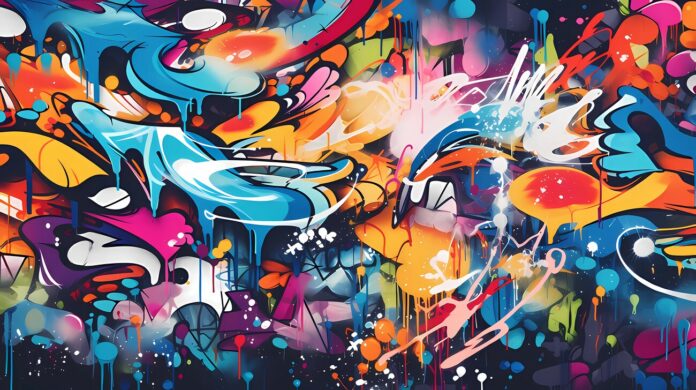Colorful graffiti art stands at the intersection of urban expression and social commentary, redefining public spaces while engaging a diverse audience. As vibrant splashes of paint disrupt monotony of city aesthetics, this art form propels us into deeper reflections about culture, identity, and community. By harnessing the power of color, graffiti acts as a vehicle for voices often marginalized, creating a canvas for societal dialogues. This exploration endeavors to unravel the complexities of colorful graffiti art, examining its historical foundations, societal implications, and the emotional responses it elicits.
The historical trajectory of graffiti art is a tapestry woven with cultural influences, socio-political events, and individual creative impulses. Initially surfacing as clandestine markings on urban surfaces, graffiti was predominantly perceived as vandalism, its intrinsic value overshadowed by its rebellious connotation. The late 20th century heralded a transformation in this perception as artists began to harness graffiti’s visual potency, utilizing it as a medium for artistic expression rather than mere defiance. Cities such as New York and London burgeoned with an effervescence of color, where street corners morphed into open-air galleries; this burgeoning movement laid the groundwork for the emergence of colorful graffiti as a legitimate art form.
Exploring the pigment-laden murals that adorn urban landscapes reveals a rich amalgamation of styles, techniques, and cultural narratives. From the audacious tags that emblazon subway cars to the intricate stencils that proliferate public walls, each emblem represents a unique dialect of artistry. The vibrancy of colors employed in graffiti transcends mere aesthetics; it invites a dialogue with observers, sparking introspection and fostering communal engagement. The works of artists like Banksy and Shepard Fairey epitomize the potential of graffiti to blend visual appeal with poignant messages, often addressing themes of social justice, environmentalism, and political disillusionment.
In examining the societal implications of colorful graffiti art, one must consider its role as a form of resistance. Graffiti can serve as a tool of empowerment, especially within marginalized communities, as it offers a voice and visibility to those traditionally relegated to the periphery. This art form enables individuals to articulate their lived experiences, challenge prevailing narratives, and forge connections with a global audience. The color palettes chosen by graffiti artists often reflect cultural identities, resonating with viewers through shared histories and contemporary struggles.
Moreover, colorful graffiti art acts as a catalyst for urban revitalization. Through murals and large-scale public artworks, neglected neighborhoods can undergo a metamorphosis, as artistic interventions instill pride and a sense of belonging among residents. Initiatives that engage local communities in graffiti creation foster a collective identity, transforming public spaces into vibrant hubs of creativity. As cities embrace colorful murals, they simultaneously acknowledge the richness of cultural diversity, leveraging graffiti as an instrument for inclusive dialogue and celebration.
However, this artistic revolution is not without contention. The duality of graffiti as both art and vandalism continues to spark debate among city planners, artists, and the general public. While some view colorful murals as a breath of fresh air, others perceive them as visual pollution that mars the ‘purity’ of urban architecture. This dichotomy underscores the need for a more nuanced understanding of graffiti as a legitimate artistic practice that not only beautifies but also communicates complex messages, fostering a shift in perspective regarding public art.
As colorful graffiti art garners increasing acceptance, it also incites curiosity regarding its potential for innovation and evolution. The advent of digital technologies has ushered in new avenues for artists to explore, blurring the boundaries between traditional graffiti and digital realms. Artists are now exploring augmented reality applications, projected graffiti, and interactive installations, prompting a reevaluation of how we perceive street art in contemporary society. Such advancements usher in an exciting era, challenging the conventions of graffiti while simultaneously reaffirming its role as a significant means of expression.
An examination of emotional responses to colorful graffiti art elucidates its capacity to resonate with viewers on a visceral level. The kaleidoscopic hues that embellish urban landscapes evoke feelings of joy, nostalgia, and contemplation. As observers encounter vibrant murals, they are often struck by the dichotomy of transience and permanence that graffiti embodies—art that exists in public spaces, yet is ephemeral by nature. Such juxtapositions compel viewers to engage more deeply, prompting them to ask profound questions about ownership, memory, and the role of art in shaping collective narratives.
Furthermore, community-led graffiti initiatives have emerged as powerful mechanisms for social change. From large-scale mural projects addressing issues of racial inequality to artworks that promote mental health awareness, these endeavors harness colorful graffiti to cultivate environments that foster dialogue and support. These initiatives highlight the capacity of graffiti to transcend the individual artist’s vision, creating a collective impact that echoes within communities. By participating in the creation of colorful murals, residents feel a sense of agency and empowerment, further entrenching the importance of communal identities within urban frameworks.
The allure of colorful graffiti art lies not solely in its aesthetic qualities but also in its capacity to incite change. By daring to challenge societal norms and explore complex themes, graffiti transcends traditional boundaries of artistic expression. As cities become canvases for vibrant murals, the implications of graffiti extend beyond the visual realm, fostering curiosity and prompting a reconsideration of what constitutes art in the public sphere.
In light of these observations, it becomes imperative to champion graffiti as a legitimate artistic phenomenon, deserving of both respect and critical scrutiny. The permutations of meaning embedded within colorful graffiti serve as a testament to its enduring relevance in contemporary culture. By nurturing a more inclusive understanding of public art, we can appreciate the multifaceted dimensions of colorful graffiti and its potential to instigate meaningful dialogue, foster innovation, and reshape our urban landscapes.





























